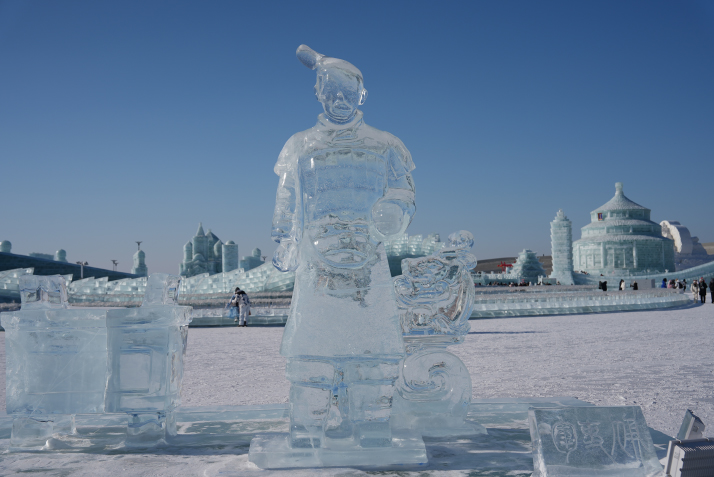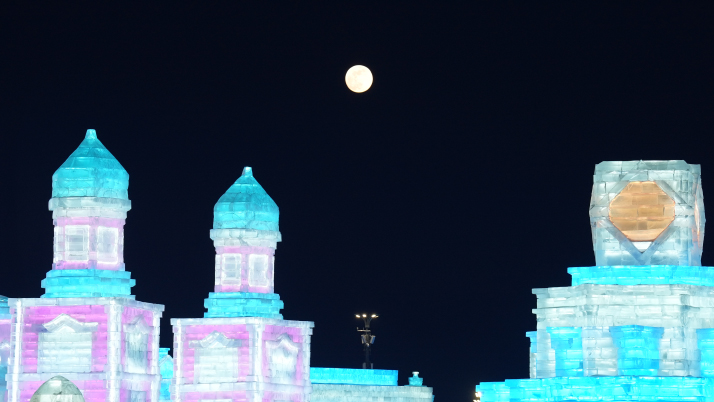| China |
| Ice sculptors heat up the tourism scene with masterpieces | |
|
|
|
Constructed from 300,000 cubic meters of ice and snow, the 26th Harbin Ice and Snow World was an icy wonderland, receiving over 2 million visitors during its 37-day run, from its opening on December 21, 2024, until January 26.
A big part of its allure lay in its wide array of intricate sculptures. Highlights included a stunning 43-meter-tall ice tower made from 13,000 cubic meters of ice, delicately carved animals, recreations of iconic figures from Chinese history, and mythical gods and beasts from foreign fairy tales. The sculptures also drew inspiration from the 2025 Asian Winter Games, held in Harbin, capital of Heilongjiang Province in northeast China, from February 7 to 14. The ice and snow sculptures reflect the countless hours of dedication and skill of their talented sculptors. Zhang Xin, a 49-year-old ice sculptor from Heilongjiang, has been ice sculpting for 15 years. A fine arts major, he began studying ice sculpting during his graduate studies. He later went on to become the first ice sculpting teacher in the country. Many of the sculptures gracing this year's icy extravaganza were created by him. Winter temperatures in Harbin usually fluctuate between minus 10 and minus 30 degrees Celsius, with the biting north wind sharp as a razor blade. The extreme cold poses an inevitable challenge for ice sculpture creation. "It is not uncommon for ice carvers to suffer from frostbite or arthritis. But despite this, we must engage in intensive work because ice carving is extremely seasonal and constrained by temperature. The sculptures must be completed within a certain timeframe," Zhang explained. Additionally, the brittle nature of ice makes it highly susceptible to damage, and any minor fault can render the entire work irreparable. According to Zhang, the average ice sculptor works more than 12 hours a day. Severe cold aside, to create large-scale ice sculptures, sculptors often need to work high above the ground, which undoubtedly adds additional challenges to the job. Still, Zhang described ice sculpting as "stressful but also stress-relieving work." When it is freezing cold and everything is silent, he can concentrate intently on his work, listening to the creaking sound from the collision of his blade with the ice, as if the ice is talking to him.  An ice replica of a terracotta warrior at the 26th Harbin Ice and Snow World in Harbin on February 12
The ice bridge In 2012, Zhang was invited by the city of Turin, Italy, to participate in an exchange event ahead of the New Year. At the event, he presented two artworks: a Santa Claus and a Luckystar, an auspicious god in Chinese folklore. The juxtaposition of these two elderly figures sparked much discussion and garnered widespread acclaim. Afterward, he received a personal letter of gratitude from the city's mayor. This experience made him realize the role of ice sculptures in cultural exchange and motivated him to incorporate more elements of Chinese culture into his creations. As a regular participant in overseas exhibitions, he has been deeply touched by the reactions of international audiences. "They were all amazed upon seeing the Chinese dragon, giant panda, the Terracotta Army and other ice sculptures with Chinese cultural elements, which made me very proud," he said. His extensive involvement in researching ice and snow sculpting art and techniques has also allowed him to explore the academic aspects of this craft. In his view, the primary difference between Chinese and Western ice sculptures lies not in techniques, but in design philosophy. "Chinese ice sculptors tend to favor realism in their models, focusing on the overall layout and harmony, and striving for an effect that is both grand and delicate. Some Western ice sculptors are more inclined to explore the intrinsic properties of ice itself, enhancing the expressiveness of their work through subtle changes and details like light and shadow, or combining advanced technologies to convey abstract themes," Zhang elaborated. He also provided an example that inspired new ideas for him: "When selecting materials, we Chinese sculptors strive to choose flawless, pure ice. In contrast, many international artists prefer ice with a natural, textured appearance or even cracks, to enhance the expressiveness of their work. If we approach snow and ice from a materials science perspective, it could expand the possibilities for ice and snow sculptures." Icebreakers Zhang's extensive experience in the field has provided him with a thorough understanding of the current state and market development trends in the global ice and snow sculpture industry. He noted that, for example, only a few countries have explored colored ice sculptures. "The addition of colors enriches the artistic expression of the original pure, crystal ice, opening up a new direction for the future development of this field," Zhang said. "However, most pigments available on the market are industrial-grade, prone to fading, and not very environmentally friendly." Zhang has teamed up with Chen Wenshuai and Zhang Chunlei, researchers at China's Northeast Forestry University, to find a better solution for the creation of such sculptures. According to Chen, when conventional water-soluble pigment freezes, the distribution of its molecules is often uneven, leading to varying shades of color. To achieve a more saturated and durable color in ice, Chen's team undertook countless experiments and design trials, exploring and fine-tuning factors such as pigment dispersion and freezing temperature, to control pigment concentration and expand the range of available colors.  An ice castle built with ice-dyeing technology at the 26th Harbin Ice and Snow World in Harbin, Heilongjiang Province, on February 12
Visuals, however, are not the team's ultimate goal. "Snow and ice are natural gifts, and our core purpose is to ensure that the entire sculpture remains natural and pollution-free," Chen said. They chose to extract pigments from trees, flowers and other plants in Heilongjiang to ensure all additives are not only safe for humans but also benefit the environment. "Eventually, these ingredients are designed to decompose into the soil, serving as fertilizer," Chen added. In the next step, the team will continue to expand the range of pigment colors and adjust the shades to create a visually pleasing effect. "We believe this safe, eco-friendly and cost-effective approach will contribute to the high-quality and sustainable development of Heilongjiang's ice and snow economy," Zhang said. (Print Edition Title: Frosted Fantasies) Copyedited by Elsbeth van Paridon Comments to kangcaiqi@cicgamericas.com |
|
||||||||||||||||||||||||||||||
|
